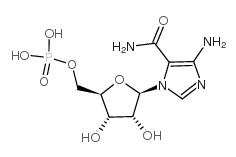Aica ribonucleotide

Aica ribonucleotide structure
|
Common Name | Aica ribonucleotide | ||
|---|---|---|---|---|
| CAS Number | 3031-94-5 | Molecular Weight | 338.21 | |
| Density | 2.3g/cm3 | Boiling Point | 845.3ºC at 760 mmHg | |
| Molecular Formula | C9H15N4O8P | Melting Point | 198-202ºC dec. | |
| MSDS | USA | Flash Point | 465ºC | |
|
In vitro and in vivo anticancer effects of mevalonate pathway modulation on human cancer cells.
Br. J. Cancer 111(8) , 1562-71, (2014) The increasing usage of statins (the 3-hydroxy-3-methylglutaryl-coenzyme A reductase inhibitors) has revealed a number of unexpected beneficial effects, including a reduction in cancer risk.We investigated the direct anticancer effects of different statins ap... |
|
|
Site-directed mutagenesis of catalytic residues in N(5)-carboxyaminoimidazole ribonucleotide synthetase.
Biochemistry 52(37) , 6559-67, (2013) N(5)-CAIR synthetase, an essential enzyme in microorganisms, converts 5-aminoimidazole ribonucleotide (AIR) and bicarbonate to N(5)-CAIR with the aid of ATP. Previous X-ray crystallographic analyses of Aspergillus clavatus N(5)-CAIR synthetase postulated that... |
|
|
Genistein suppresses LPS-induced inflammatory response through inhibiting NF-κB following AMP kinase activation in RAW 264.7 macrophages.
PLoS ONE 7(12) , e53101, (2012) Genistein, the major isoflavone in soybean, was recently reported to exert beneficial effects in metabolic disorders and inflammatory diseases. In the present study, we investigated the effects and mechanisms of a dietary concentration of genistein on the inf... |
|
|
Phenformin activates the unfolded protein response in an AMP-activated protein kinase (AMPK)-dependent manner.
J. Biol. Chem. 288(19) , 13631-8, (2013) The cross-talk between UPR activation and metabolic stress remains largely unclear.Phenformin treatment activates the IRE1α and PERK pathways in an AMPK-dependent manner.AMPK is required for phenformin-mediated IRE1α and PERK activation.Our findings demonstra... |
|
|
Methotrexate promotes glucose uptake and lipid oxidation in skeletal muscle via AMPK activation.
Diabetes 64(2) , 360-9, (2015) Methotrexate (MTX) is a widely used anticancer and antirheumatic drug that has been postulated to protect against metabolic risk factors associated with type 2 diabetes, although the mechanism remains unknown. MTX inhibits 5-aminoimidazole-4-carboxamide ribon... |
|
|
AMP-activated protein kinase regulates intraocular pressure, extracellular matrix, and cytoskeleton in trabecular meshwork.
Invest. Ophthalmol. Vis. Sci. 55(5) , 3127-39, (2014) In this study, we investigate how adenosine monophosphate-activated protein kinase (AMPK) affects extracellular matrix (ECM) and cellular tone in the trabecular meshwork (TM), and examine how deletion of its catalytic α2 subunit affects IOP and aqueous humor ... |
|
|
The full capacity of AICAR to reduce obesity-induced inflammation and insulin resistance requires myeloid SIRT1.
PLoS ONE 7(11) , e49935, (2012) Chronic Inflammation is a key link between obesity and insulin resistance. We previously showed that two nutrient sensors AMP-activated protein kinase (AMPK) and SIRT1 interact to regulate macrophage inflammation. AMPK is also a molecular target of 5-aminoimi... |
|
|
Inhibition of the mitochondrial Hsp90 chaperone network: a novel, efficient treatment strategy for cancer?
Cancer Lett. 333(2) , 133-46, (2013) Research has shown that cancer cells exhibit multiple deregulated pathways, involving proliferation, migration and cell death. Heat-shock-proteins have evolved as "central regulators" and are implicated in the modulation of these pathways and in organelle-spe... |
|
|
The human glucagon-like peptide-1 analogue liraglutide regulates pancreatic beta-cell proliferation and apoptosis via an AMPK/mTOR/P70S6K signaling pathway.
Peptides 39 , 71-9, (2013) Glucagon-like peptide-1 (GLP-1), an effective therapeutic agent for the treatment of diabetes, has been proven to protect pancreatic beta cells through many pathways. Recent evidence demonstrates that AMP-activated protein kinase (AMPK), as a metabolic regula... |
|
|
Metformin-stimulated AMPK-α1 promotes microvascular repair in acute lung injury.
Am. J. Physiol. Lung Cell. Mol. Physiol. 305(11) , L844-55, (2013) Acute lung injury secondary to sepsis is a leading cause of mortality in sepsis-related death. Present therapies are not effective in reversing endothelial cell dysfunction, which plays a key role in increased vascular permeability and compromised lung functi... |